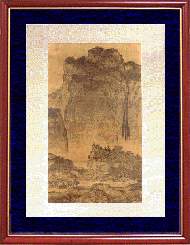`
 |
|
18"x24" |
Fan K¡Šuan (fl. 10th c.), Sung Dynasty
Original: Hanging scroll, ink and light colors on silk, 206.3 x 103.3 cm
 |
 |
 |
 |
Fan K¡Šuan, a native of Shensi province, often traveled the area between the capital and Loyang. Although he was known for his magnanimous character, upright personality, as well as fondness of drink and the Way, he is renowned for landscape painting. In his early study of painting, he followed the style of the Shantung artist Li Ch¡Šeng (919-967). Later, however, he came to realize that if he really wanted to portray the land, he had to take Nature as his teacher rather than other artists or their works. After all, landscape exists in nature and in the mind of the artist. Fan K¡Šuan thereupon went to Mt. Hua and secluded himself among the forests and mountains, devoting himself to observing the effects of atmospheric, weather, and seasonal changes on the scenery. Therefore, contemporaries praised him for being able to commune with the mountains. This sole surviving masterpiece is a testament to his skills and ideas in landscape painting.
The clusters of vegetation at the top of the tall mountain are actually distant forests clinging to a precarious perch. Running along the central axis of the scroll, the central mountain dominates the scene in a classic example of Northern Sung monumental landscape painting. The rooftops of a building complex stand out in the right middleground. By the cluster of rocks in the right foreground is a path on which a mule train makes its way. A cascade as slender as silk falls from the heights above, ending up as the stream rushing down in eddies towards the foreground. From near to far, Fan K¡Šuan has described with realistic detail the solemn grandeur of a majestic landscape.
Fan K¡Šuan rendered the mountains and slopes with jagged outline strokes and filled them with brush dabs resembling raindrops--techniques which highlight the monumental and eternal features of the mountains. To the right of the mule train, among the leaves, is the signature of Fan K¡Šuan, a final touch by the artist to suggest the insignificance of man (including himself) compared to Nature.
¡@